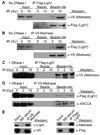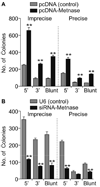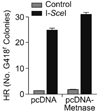The human set and transposase domain protein Metnase interacts with DNA Ligase IV and enhances the efficiency and accuracy of non-homologous end-joining
- PMID: 18773976
- PMCID: PMC2644637
- DOI: 10.1016/j.dnarep.2008.08.002
The human set and transposase domain protein Metnase interacts with DNA Ligase IV and enhances the efficiency and accuracy of non-homologous end-joining
Abstract
Transposase domain proteins mediate DNA movement from one location in the genome to another in lower organisms. However, in human cells such DNA mobility would be deleterious, and therefore the vast majority of transposase-related sequences in humans are pseudogenes. We recently isolated and characterized a SET and transposase domain protein termed Metnase that promotes DNA double-strand break (DSB) repair by non-homologous end-joining (NHEJ). Both the SET and transposase domain were required for its NHEJ activity. In this study we found that Metnase interacts with DNA Ligase IV, an important component of the classical NHEJ pathway. We investigated whether Metnase had structural requirements of the free DNA ends for NHEJ repair, and found that Metnase assists in joining all types of free DNA ends equally well. Metnase also prevents long deletions from processing of the free DNA ends, and improves the accuracy of NHEJ. Metnase levels correlate with the speed of disappearance of gamma-H2Ax sites after ionizing radiation. However, Metnase has little effect on homologous recombination repair of a single DSB. Altogether, these results fit a model where Metnase plays a role in the fate of free DNA ends during NHEJ repair of DSBs.
Conflict of interest statement
The authors declare that there are no conflicts of interest.
Figures







Similar articles
-
Metnase/SETMAR: a domesticated primate transposase that enhances DNA repair, replication, and decatenation.Genetica. 2010 May;138(5):559-66. doi: 10.1007/s10709-010-9452-1. Epub 2010 Mar 23. Genetica. 2010. PMID: 20309721 Free PMC article. Review.
-
The transposase domain protein Metnase/SETMAR suppresses chromosomal translocations.Cancer Genet Cytogenet. 2010 Jul 15;200(2):184-90. doi: 10.1016/j.cancergencyto.2010.04.011. Cancer Genet Cytogenet. 2010. PMID: 20620605 Free PMC article.
-
Crystal structure of the human Hsmar1-derived transposase domain in the DNA repair enzyme Metnase.Biochemistry. 2010 Jul 13;49(27):5705-13. doi: 10.1021/bi100171x. Biochemistry. 2010. PMID: 20521842
-
Human Pso4 is a metnase (SETMAR)-binding partner that regulates metnase function in DNA repair.J Biol Chem. 2008 Apr 4;283(14):9023-30. doi: 10.1074/jbc.M800150200. Epub 2008 Feb 8. J Biol Chem. 2008. PMID: 18263876 Free PMC article.
-
Mechanisms of DNA double strand break repair and chromosome aberration formation.Cytogenet Genome Res. 2004;104(1-4):14-20. doi: 10.1159/000077461. Cytogenet Genome Res. 2004. PMID: 15162010 Review.
Cited by
-
The DNA repair component Metnase regulates Chk1 stability.Cell Div. 2014 Jul 9;9:1. doi: 10.1186/1747-1028-9-1. eCollection 2014. Cell Div. 2014. PMID: 25024738 Free PMC article.
-
Distinct roles of structure-specific endonucleases EEPD1 and Metnase in replication stress responses.NAR Cancer. 2020 Jun;2(2):zcaa008. doi: 10.1093/narcan/zcaa008. Epub 2020 Jun 8. NAR Cancer. 2020. PMID: 32743552 Free PMC article.
-
SETMAR Shorter Isoform: A New Prognostic Factor in Glioblastoma.Front Oncol. 2022 Jan 3;11:638397. doi: 10.3389/fonc.2021.638397. eCollection 2021. Front Oncol. 2022. PMID: 35047379 Free PMC article.
-
SETMAR isoforms in glioblastoma: A matter of protein stability.Oncotarget. 2017 Feb 7;8(6):9835-9848. doi: 10.18632/oncotarget.14218. Oncotarget. 2017. PMID: 28038463 Free PMC article.
-
Maintenance of imaginal disc plasticity and regenerative potential in Drosophila by p53.Dev Biol. 2012 Jan 15;361(2):263-76. doi: 10.1016/j.ydbio.2011.10.012. Epub 2011 Oct 19. Dev Biol. 2012. PMID: 22036477 Free PMC article.
References
-
- Shrivastav M, De Haro LP, Nickoloff JA. Regulation of DNA double-strand break repair pathway choice. Cell Res. 2008;18:134–147. - PubMed
-
- Weterings E, Chen DJ. The endless tale of non-homologous end-joining. Cell Res. 2008;18:114–124. - PubMed
-
- Fu YP, Yu JC, Cheng TC, Lou MA, Hsu GC, Wu CY, Chen ST, Wu HS, Wu PE, Shen CY. Breast cancer risk associated with genotypic polymorphism of the nonhomologous end-joining genes: a multigenic study on cancer susceptibility. Cancer Res. 2003;63:2440–2446. - PubMed
-
- Lee JH, Paull TT. ATM activation by DNA double-strand breaks through the Mre11-Rad50-Nbs1 complex. Science. 2005;308:551–554. - PubMed
MeSH terms
Substances
Grants and funding
LinkOut - more resources
Full Text Sources
Research Materials

